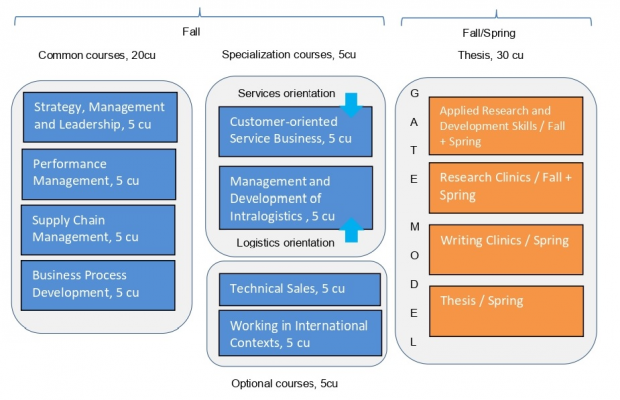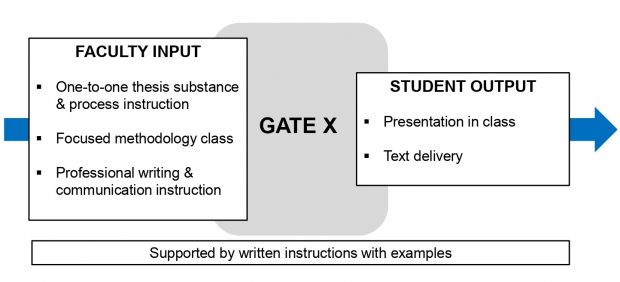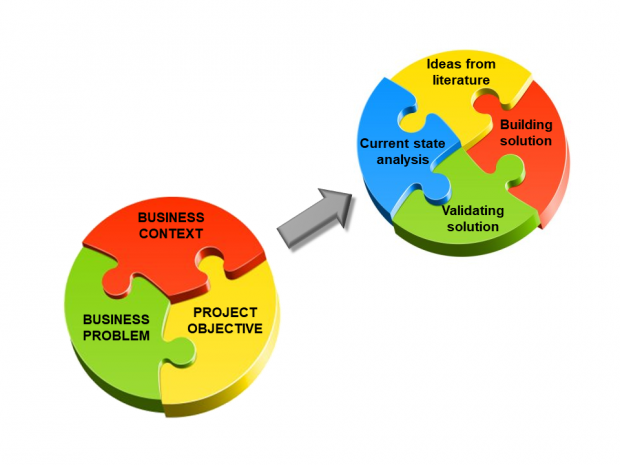This is Text 1 in a 3-part series of texts focusing on the benefits of the Metropolia Industrial Management (IM) Master’s Program’s overall design aimed at catering to professionals, often engineers or team leaders, looking to make a career leap from engineering toward management positions. The other two texts will take a closer look at two key components in the program. Text 2 will focus on the benefits of the Gate model utilized in the IM Thesis process and Text 3 on the specific benefits of the Writing Clinics providing one-on-one guidance and using IM Thesis template as a key tool.
I have been part of this program for almost 10 years and for the past few years I have been mainly providing language and communication instruction and language guidance during the thesis process. The main aim of this blog series is to share my observations and learnings with instructors interested in adopting scientifically sound, systematic and holistic research and business principles – that produce quality results – into their pedagogical toolbox.
Industrial Management Master’s Program
The 1-year IM Master’s program is worth 60 cu altogether with one half of the credits earned from the common, specialization and optional courses (blue boxes) and the other half from the Thesis (orange boxes), as shown in Image 1 below. The substance teaching taking place in the fall term includes literature readings on several current management topics such as strategy and leadership, process development, supply chain management and performance management plus students’ specialization related topics. All of these are feeding particularly the theoretical section of the thesis, written and completed in the spring.

Image 1. IM Master’s Degree Program structure (modified from Haimala, 2020)
Importantly, the program has been developed further every year ever since its inception in 2006. The development has been done using action research principles thus ensuring pedagogically and methodologically sound teaching and learning experiences for professional adult learners, for instance through learner empowerment and authenticity of material and activities (see Huhta 2010).
Gate Model in Brief
In practice, the students complete their studies in 9 months only, from September to May. This is why a systematic 7-Gate model has been designed to ensure timely graduation and a quality final product, i.e. a practical, logical and well-grounded Master’s thesis in Industrial Management.
To guarantee a systematic approach to the thesis studies, the program applies key concepts and methods from design research/applied action research (see e.g. Saunders et al. 2016; Kananen 2013) as well as from product innovation and development through the application of a system called the Gate model (see Cooper 2008). Cooper, a Professor of marketing, originally created the gate system for moving new product development projects through the various stages and steps from idea to launch to achieve improved cycle times and commercially successful final products. Cooper’s system consists of gates, each with its own set of metrics and criteria for passing the gates, similar to quality-control checks in production. In the context of the IM Master’s thesis studies, the idea of gates has been harnessed to serve both the thesis instruction and writing process
WHAT IS A GATE? As shown in Image 2, it is a preparation to allow the student to create one key component of the Master’s Thesis at a time, from Introduction to Conclusions. Each gate must be completed before moving on to the next Gate.

Image 2. Gate model (modified from Rohweder, 2020)
As Image 2 depicts, each Gate consists of Faculty input and student output and needs to be passed before moving to the next Gate. Let’s take Gate 1 as an example:
- Gate 1 faculty input is about Scoping the thesis project and thus the methodology class focuses on three key points: introducing the business context, identifying practical business problem and setting project objective.
- The first Gate 1 student output is a simple presentation slide explaining the business context, thesis objective and expected outcome of their thesis project and presenting it in class with immediate feedback from both peers and IM team in order to finetune the logic.
- The second Gate 1 student output is the Thesis Chapter 1 Introduction. It introduces the thesis topic to the reader from the perspective of the points mentioned above.
The Gate model proceeds in this fashion Gate by Gate until Gate 7, which completes the Thesis project. The 7 gates provide a blueprint for successfully producing and completing the different steps in the thesis process resulting in a quality outcome for all stakeholders, i.e. the student, the university and employer organization. The complete Gate model and how design research principles have been implemented to the Gate model will be explained in detail in text 2 of this series.
Students
At the very center of the IM degree program are the students representing a number of leading industrial companies such as Kone, Outotec, Vaisala, Fortum and ABB, to mention only a few. The students have on average 5-6 years of work experience and so they bring with them their professional expertise for the benefit of all program participants.
The students tend to quickly form quite a strong and active peer community of learners thanks to their varied competences and skills. Since the studies have been integrated into real-life, practical business projects from their employer organizations, the students are able to continue working while studying. In this sense, the nature of the IM Master’s program is quite exceptional, if compared for instance with Master’s programs in science universities where the IM Master’s students typically are 20 something students with no or very little industry expertise.
Faculty
On the faculty side, the three main instructors all have doctorate degrees and decades of work experience in expert and managerial positions in industrial organizations. The common, specialization and optional courses are taught individually by these instructors, whereas the Gate model Thesis instruction is organized around the concept of genuine integration of having all instructors in the IM team present in the classroom, including me as the language expert, with each instructor bringing their own expertise on the table.
Teaching and guidance
Tuition in the IM Master’s program is in English. In normal circumstances, the courses are heavily centered around contact teaching in the form of interactive lectures and class discussions, but due to the Covid-19 pandemic teaching has recently gone online. However, contact teaching will make a comeback the minute the recommendations for distance studies are removed as face-to-face contact teaching is the heart of the program. Other methods of studying include teamwork, class discussions, business simulations, self-study, workshops and seminars.
The soul of the program is the amount of face-to-face consultancy and guidance from faculty members which provides the students with numerous opportunities for receiving individual advice, development and help in their learning process. Instead of exams, the students are given practical assignments that are graded individually. For grading the thesis, the grading committee consisting of the IM team members utilizes a comprehensive set of evaluation criteria as shown in the PDF document behind this link.
Benefits in Nutshell
The objective of the program design that is continuously developed based on best practise has been all along to produce a truly integrated, inspiring entity that brings value to all stakeholders. The benefits (Rohweder, 2020) of this systematic program design for all stakeholders are significant including:
- STUDENT
- On-time graduation
- Thesis quality
- Business development concept ”for life”
- INDUSTRY
- Professionals with systematic evidence-based problem solving skills
- METROPOLIA
- On-time graduating students
- Thesis quality
- Positive student feedback
This here is obviously a win-win-win situation and the fruit of consistent and systematic development work.
This first text provided an overall view of the benefits of systematic program design in Metropolia Industrial Management Master’s Program. Text 2 of this 3-part series will continue from here in October by providing an in-depth look into the Gate model, the brains of the program. Text 3 will follow shortly after focusing on the specific benefits of the Writing Clinics providing one-on-one guidance and using IM Thesis template as a key tool.
References
Cooper, R. (2008) “The Stage-Gate Idea-to-Launch Process–Update, What’s New and NexGen Systems,” in Journal of Product Innovation Management, Volume 25, Number 3, May 2008, pp 213-232
Haimala, J. (2020). Industrial Management Studies 2020-21. Orientation Day slides. Metropolia University of Applied Sciences. Delivered 10 September, 2020.
Huhta, M. (2010). Language and Communication for Professional Purposes: Needs Analysis Methods in Industry and Business and their Yield to Stakeholders. Department of Industrial Engineering and Management. Helsinki University of Technology.
Kananen, J. (2013). Design research (applied action research) as thesis research: A practical guide for thesis research. Jyväskylä: Jyväskylän ammattikorkeakoulu
Rohweder, T. (2020) Gate 1 Teaching slides. Metropolia University of Applied Sciences. Delivered 18 September, 2020.
Saunders, M., Lewis, P. & Thornhill, A. (2016). Research methods for business students. 7th ed. Harlow: Pearson Education.









Ei kommentteja